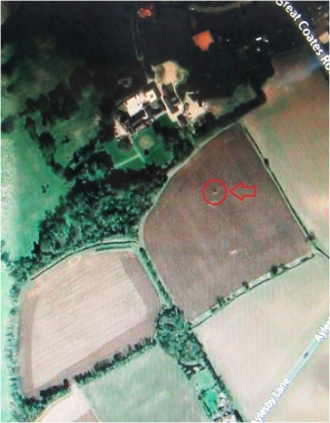
One of the positives of the lockdown is exploring discovering and researching our own local area. We have lived in the village of Healing in North Lincolnshire for over two years but have really seen very little of it but with wider restrictions on travel we have been exploring the lanes and bridlepaths nearby.
Today we walked in a different direction because I wanted to find the redundant watercress beds which I had read were once numerous here and about.

The area was perfect for watercress production on account of the many underlying aquifers which brought spring water with a slight alkalinity, perfect for watercress from the chalk layers in the nearby Lincolnshire Wolds, just a few miles to the south. As well as the natural ‘blow wells’ bore holes were sunk to bring this pure alkaline water to the surface.
‘Blow wells’ are a type of groundwater spring and are a unique feature of North Lincolnshire. A blow well is a type of groundwater spring, which is seldom (if at all) found across the British Isles except for the coastal margins of Lincolnshire.
This a simple geological explanation (simple because I am not a real geologist).
Rain falling and percolating through the chalk of the Lincolnshire Wolds creates underground streams that flow under the marshland towards the Humber Estuary and becomes covered by impermeable compressed clay. Under this heavy boulder clay the groundwater is under great pressure (artesian) and in certain conditions, where there is an opening in the clays from the chalk to the surface and there is sufficient downward pressure from the heavy soil above, the groundwater emerges – a ‘Blow well’.

Today Anglian Water Company supplies water to North Lincolnshire by sinking bore holes several hundred feet deep to release the water from the chalk below (abstraction) before it flows away into the Humber and out into the North Sea. Water here is not provided from surface reservoirs.
The watercress beds were built with a slight gradient and water was directed through a channel into the highest end and then allowed flow gently down the length of the bed before leaving through a narrow opening at the lower end. The watercress was gathered by hand and put onto wooden trays before being taken to a packing shed where it was divided into bundles, labelled and then the roots cut off. The bunches were then packed into wooden baskets, known as chips and transported by away for delivery to customers. The severed roots were returned to the watercress bed where they were replanted.

The site is near Healing Station, and much of the watercress produced was transported by train to towns throughout the North of England. However, as British Rail cut back on their freight services in the 1960s, the watercress trade at Healing was badly affected as it was much more difficult to get the cress to the town markets early enough by road (there was no motorway link until 1983) so commercial production of watercress at Healing finally came to an end in 1970.
Healing Station today is a village stop with infrequent trains but a hundred years ago was a busy commercial station with a goods yard and a steady turnover of freight. All gone now of course.
There is no watercress farming now either and the site is a nature reserve but watercress continues to grow in the dykes and drainage ditches that drain the land. Kim challenged me to pick some for our salad but the ditches are steep sided and challenging and the water a little dirty so I got some from the supermarket the next day instead.



























































